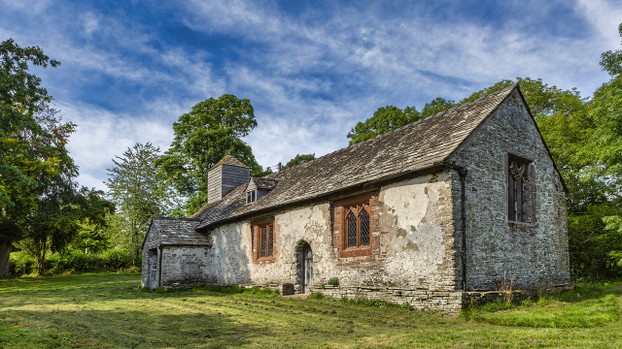As the Sun rose over the near silence of the mountain morning the pilgrims breakfasted and eschewing the rocky higher slopes, hiked along the trail through the mixture of bracken, grass and gorse of the lower slopes, heading for the large cascade of Aber Falls, the last stage of a river as it tumbles seaward. The pilgrims, some of whom were inexperienced in outdoor pursuits, were in one or two cases awestruck. Then they set off for their destination, the spectacular cascade of Aber Falls, which was for one pilgrim a new experience. I think that the waterfall inspired awe and was primarily a time for enjoyment, testimony to the enjoyability of the spiritual, which is not gloomy as some secular people think.
The distance was not far compared with other pilgrim paths, a mere hundred and ninety miles from their starting point at Flint Castle, so there was time for a detour, with the locations chosen to adhere to the spiritual theme of the journey. So the group was divided into two for a day, one group going up Yr Wydfa, known in English as Snowdon, while the other visited Anglesey, the one time centre of the ancient British religion of druidry.. Both groups followed a similar conversational path, eschewing theological discussions to concentrate on the spiritual and emotional problems that various individuals among them felt. This was not a departure from the task at hand, for religions are often about healing body, mind and spirit, so the easing of spiritual burdens as happened in the case of a woman coming to terms with a divorce was a welcome experience, while the Muslim man was able to come to some acceptance of the death of his beloved mother.
But was Yr Wydfa a spiritual experience? The key to understanding the climb up the highest mountain in Wales and England is the concept of liminality, the idea that some places are thin, which means that the other world shines through them. Liminal places include mountain tops and sites of great natural beauty. Druidry, the religion of the Britons, believed that the divine was encountered through the medium of nature, and the pilgrims became acutely aware of this concept in their mountain walk..
The Anglesey group did two things, visiting a boggy pool where votive offerings had been found, including a slave chain. The discovery of the link with slavery provoked profound reflection. Then they went on to a megalithic tomb which seemed to be the remnant of a barrow, an artificial mound used to inter the dead, in this cave a stone age community who lived and were buried together. This prompted the pilgrims to ponder upon death, and think about the ways in which beliefs about ultimate things differ among individual communities have elements in common. The Muslim, who despite being a very big man carrying much weight, had shown impressive perseverance on the walk, had never experienced any religion other than Islam, Judaism and Christianity came to see that the tomb was testimony to the fact that there are beliefs other than those three, though the trip included one Jain, so he was being prepared for a new experience.










 Pilgrimage. A review16 days ago
Pilgrimage. A review16 days ago
 Leo the Fourteenthon 05/09/2025
Leo the Fourteenthon 05/09/2025
 The Melsonby Hoardon 03/25/2025
The Melsonby Hoardon 03/25/2025



Comments
There could be some done, but thebsoil is acidic, so bones, which are calcium based, would decay
Thank you for your comment in answer to my previous, same-day observations and questions.
In another direction from Genghis Khan ;-D, Bardsey Island intrigues me. Online sources list it as burial places of King Arthur, Merlin and 20,000 saints.
Might there have been some scanning done to number how many bones occur on Bardsey Island?
I have not seen it.
Thank you for your comment below in answer to my previous, same-day observations and questions.
The Severin book got my attention when I immersed myself in Genghis Khan-related materials because of the 2007 release of the film Mongol.
Have you seen the aforementioned film?
The connections between Tokharian and Gaelic are mysterious, especially as a great landmass separate them. But not all liminal sites overlooked the ocean. But strangely the mongol peoples, who knew not the sea, used a word related to ocean for the vast expanse of heaven above, a piece of information I took from TIM severin's book, In Search of Genghis Khan.
The second paragraph to the second subheading, Towards the waterfall, advises us that " Liminal places include mountain tops and sites of great natural beauty."
Elizabeth Wayland, in The mummies of Ürümchi, about the Tarim river basin mummies of Iranian DNA and some connection with Gaelic-speaking ancients through their Tocharian language, ascribes to Gaelic ancestors alignments to one another by beautiful, high, ocean-overlooking sites with defensible fortresses and horse-raising and textile-making activities.
Might that mean that Gaelic-ancestored sites matter as liminal places?
I love long walks, and walking down coastal paths in beautiful green scenery with a rich cultural history ticks all the boxes, as the British idiom goes.I am hopeful that my currently successful program of physiotherapy will enable me to improve my damaged walking powers and that I can get back to longer walking. I know that I will never get fully well, but some hope of improvement remains.
Thank you for this lovely presentation. I am all in for long walks, no matter how are they are called, but knowing the background defiitely adds another dimension to the experience.
St Winefrid's Well had the occasional pilgrimage, as did Walsingham
The first paragraph to the first subheading, Pilgrimage, considers that "Pilgrimages used to be part and parcel of life in Britain, but they were seriously curtailed by the Protestant reformation, which was imposed on the people by a small minority."
Is there any one pilgrimage that maintains a continuous history as most popular and most respected?